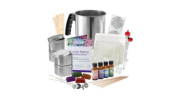login or create an account

What you MUST have - Pots and pitchers
Whether it is to melt wax (if you're using the double boiler method) or to pour that wax into your molds or your containers, you will need pots and beakers. If at all possible, several of them, of different sizes (especially if you plan on making multicolored candles).
In this article, we will review what type of containers are compatible with our candlemaking endeavors, which ones to choose and what the thrifty alternatives are.

Your needs will be different depending on whether you will be using a double boiler or a slow cooker to melt your wax. For a double boiler, you will need at least one beaker large enough and easy to clean; in this case, the best choice is a stainless steel beaker but its price can form an obstacle. If you transfer wax from a double boiler, a sturdy, heat-resistant glass beaker (Pyrex or similar) can do the trick.
Stainless steel beakers
Stainless steel is, of course, ideal: durable, light, easy to clean up afterwards... but its price tag does not work in its favour. A 34 ounces (1 liter) model is hard to find under twenty dollars. Until not that long ago, I bought my beakers from Ikea; they used to sell stainless steel beakers in three different sizes. Unfortunately, I can't find them anymore in the new catalog.
But Ikea is not your only possible source. Amazon has a few models that are fairly priced. If you will be using the double boiler method, you will either have to invest into one or two stainless steel beakers or use one of the "homemade" methods described below. I strongly advise against using glass beakers as a double boiler insert.
Glass beakers
Glass beakers, if they are heat-resistant, can perfectly be used as pouring pots. Choose them strong (the one in the picture has a handle that looks rather fragile) and large enough: at least 17 ounces (1/2 liter) but ideally 34 ounces (one liter). The glass beaker in the picture is sold by Ikea and comes in two different sizes.
Homemade beakers

The trouble with tin cans is that they do not come with a spout or with a handle. With hot paraffin wax inside, this can quickly become inconvenient (not to mention dangerous).
To remedy this, create a spout yourself with the help of pliers or a hammer (and something hard to act as an anvil). You will probably have to get rid of the small metal rim left after opening the tin, at least at the place you want the spout to be. You're more likely to have a rim with tin cans that have a pull tab (a can opener cuts close to the sides of the tin). If there is a rim, flatten it out with pliers or with a hammer, or use a file to get rid of it.
To compensate for the lack of a handle, get yourself the little accessory pictured above: it's a pot gripper frequently used by survival aficionados.
It should set you back less than ten dollars and is easy to find in stores that carry camping gear, like AS Adventure, or from Amazon.
 Thanks a bunch!
Thanks a bunch!



